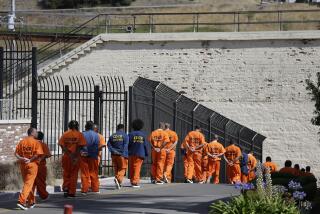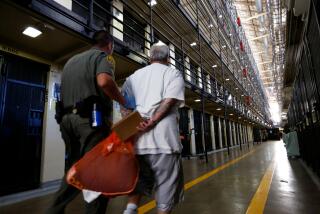Three-strikes shouldn’t be about small-time crime
SACRAMENTO — One guy stole a loaf of bread. Another was caught with a speck of meth. Somebody grabbed $1 in change from a parked car.
These men all had one thing in common besides being losers. They were sentenced to 25 years to life in prison for their crime.
Not under Taliban law in some backward, oppressive society. They were administered that severe punishment here in enlightened California under our three-strikes law.
Proposition 36 on the Nov. 6 ballot would apply some balance, prudence and logic to the sentencing of career criminals.
INTERACTIVE: 2012 California propositions
“There would be proportionate justice evenly applied while still preserving the essence of a very powerful sentencing tool,” says Los Angeles County Dist. Atty. Steve Cooley, one of Prop. 36’s leading advocates.
The three-strikes law was enacted in 1994 in the wake of the L.A. riots and the kidnap-murder of 12-year-old Polly Klaas in small-town Petaluma.
But Fresno portrait photographer Mike Reynolds was the driving force. His 18-year-old daughter Kimber had been murdered by two career criminals on a stolen motorcycle trying to snatch her purse.
Reynolds was — is — articulate, energetic, committed and street-smart. He got rolling on a ballot initiative to lock up repeat offenders before they could wreak more havoc. He also simultaneously pushed a bill in the Legislature.
“Better get the hell out of the way,” then-Assembly Speaker Willie Brown advised Democrats. They did.
The bill sailed through the Legislature. And Reynolds’ identical ballot initiative — Prop. 184 — was embraced by 72% of voters.
The official ballot argument for Prop. 184 promised it would “keep career criminals, who rape women, molest innocent children and commit murder, behind bars where they belong.”
Three-strikes has helped do that. But it also has done much more. It has kept locked up for life decrepit old men whose last crime may have been shoplifting a pair of work gloves.
It’s not that three-time losers shouldn’t be shoved back into the slammer. But for 25 years to life? This state can no longer afford that, if it ever could. Moreover, the punishment should fit the crime.
Here’s how three-strikes works: A felon who has two prior convictions for a violent or serious crime — rape, for example, or assault with intent to rob — is subject to a 25-to-life sentence, regardless of the latest offense. It could be pilfering food.
In 2004, there was a ballot initiative to soften the law. It would have been too soft for Cooley, and he strongly opposed the idea. So did then-Gov. Arnold Schwarzenegger.
Schwarzenegger paid for his own dramatic TV ad that showed a cell door clanging and the governor snarling, “Keep them behind bars.” Voters narrowly rejected the initiative.
Cooley then proposed a major tweak to the sentencing law that ultimately, in essence, became Prop. 36.
First, however, the 2006 Legislature was offered the proposed revision and meekly declined.
INTERACTIVE: Outside spending shapes 2012 election
Under Prop. 36, the third strike would have to be violent or serious before the criminal could receive a 25-to-life sentence, with some major exceptions. If a prior conviction had been for murder, rape or child molesting, for example, the 25-to-life sentence still could be administered regardless of how minor the last offense.
Even those spared a life sentence wouldn’t exactly skate. They’d serve double the normal time for the crime. They’d be punished as a two-striker.
Inmates currently imprisoned under the three-strikes law could apply for a sentence reduction if their last strike was nonviolent or non-serious.
There are about 137,000 convicts locked up in state prisons, costing taxpayers nearly $9 billion annually. About 9,000 are third-strikers. The legislative analyst estimates that $70 million could be saved by enacting Prop. 36 — not a lot, relatively, but the state is scratching for every dime.
Michael Romano, director of the Three Strikes Project at Stanford Law School, calculates that almost 3,700 third-strikers have been convicted of nonviolent or non-serious crimes. Of those, around 3,000 would benefit from Prop. 36.
“Many are among our oldest and sickest prisoners, so they’re going to cost more” to incarcerate, Romano says. “They’re the least likely to commit new crimes when they get out. The single biggest predictor of whether someone is going to commit a crime is age.”
The law lecturer adds: “They should be punished, but receiving a life sentence for stealing a pair of socks is not what the voters intended.
“Of course, these people are not innocent. But do we lock up people we’re angry with or actually scared of?”
Both. The former is for punishment, the latter for protection. But for many third-strikers, the punishment hardly fits the crime.
Still, Reynolds, the father of three strikes, adamantly opposes Prop. 36.
“If this passes, you’re looking at a sure-fire formula for more crime,” he says. “You’re talking about repeat offenders. They’re not going off to never-never land to live happily ever after.”
The California District Attorneys Assn. and several law enforcement groups oppose the measure.
“The current law is working well because district attorneys use their discretion appropriately in charging three-strikes cases,” the attorneys association asserts in a campaign document. And “judges use their discretion” to reduce felonies and dismiss prior strikes.
Cooley and the district attorneys of San Francisco and Santa Clara already have adopted their own prosecutorial policies similar to Prop. 36. But the ballot measure is needed, Cooley says, so sentencing doesn’t vary so widely around the state.
Few laws are perfect. Three-strikes certainly isn’t. It needs a little fixing.
Prop. 36 is about ending injustices and wasteful spending.
More to Read
Get the L.A. Times Politics newsletter
Deeply reported insights into legislation, politics and policy from Sacramento, Washington and beyond. In your inbox three times per week.
You may occasionally receive promotional content from the Los Angeles Times.







